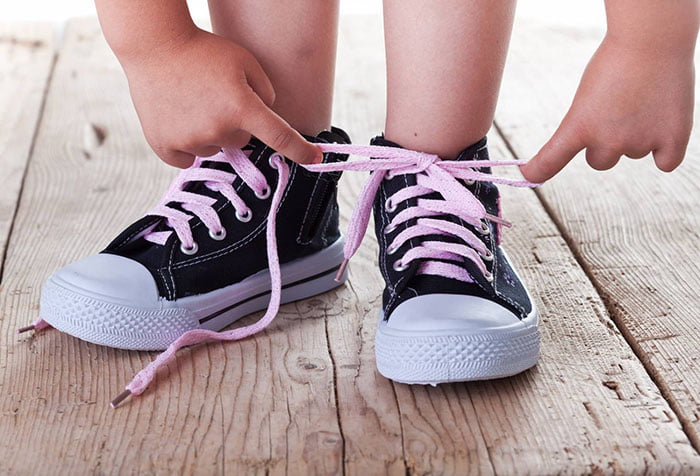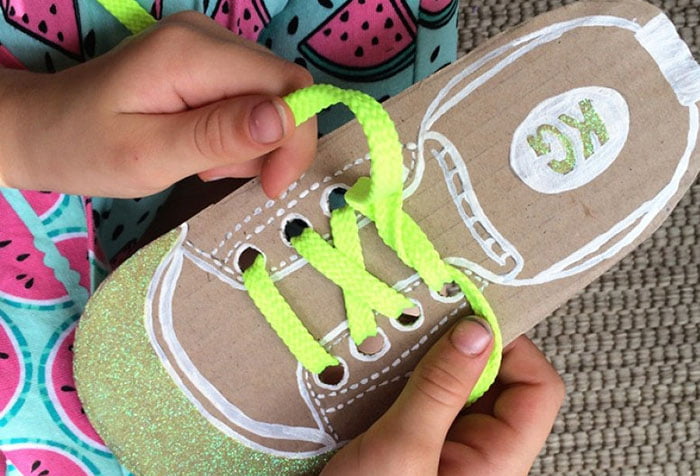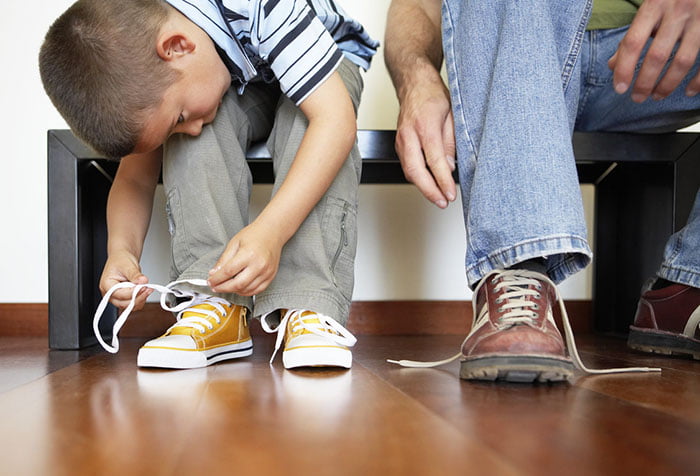How to teach a child to tie his own shoelaces?
In order for a child to fully develop and not feel like a burden, it is necessary to teach him in time one or another functional skill that will be useful to him in everyday life and will help him to exist normally in society. We learn to talk at 1 year, to walk at 1.5 years, and to tie shoelaces... when necessary.
At what age is it time to learn to tie shoelaces?
Educational psychologists answer this question in different ways. Let us turn to some written works on raising children. So, for example, in his educational program, or rather, in the strategies and tactics for raising children, the famous teacher M. Monterssori identifies several so-called zones of child development:
- zone of mental development;
- sensory zone;
- zone of practical life.
Let's pay attention to the latter. Maria Monterssori notes that this area is especially important for children. The practical life area includes skills and abilities such as the ability to look after oneself, wash oneself, get dressed, and also use various things like a zipper on a jacket, buttons on a shirt, and laces on sneakers. The teacher identifies 2.5–3.5 years as the appropriate age for teaching such things. Other experts say the age ranges from 3 to 6 years. But they all agree that the first attempts to teach a child to tie his shoes should be made when he begins to understand what he is being taught, what is being done and why it is needed.
It is awareness of your own actions that will help you quickly learn this skill.
The age of awareness falls on average at 2–3 years, depending on the child’s development, surrounding factors, his psychological health, etc. This is exactly the time when a person’s very first memories of childhood are formed and memory begins to work more actively.
Thus, we can conclude that you need to start teaching your daughters and sons to tie their shoelaces when there is a practical need for it. For example, when the baby goes to kindergarten and he needs to put on his own shoes for a walk or sneakers for physical education.
In this case, the parents’ efforts will not be in vain. After all, the baby will begin to repeat the same movements every day under your control and in the end will forever remember how to wrap the proverbial bow.

Shoelaces and fine motor skills
The development of motor skills in children's hands is no less important than teaching children to walk, talk, and potty training. It is necessary to take care of this issue from the first weeks of the baby’s life. Infants should massage their palms and fingers, stimulating the muscles and nerve endings connected to the brain. As a child grows, he is offered toys of various structures: soft, hard, with large or small parts, static or changing position. Also, kids should sculpt figures from plasticine, assemble mosaics, construction sets or puzzles with their parents - and much more.
Early development of motor skills will already be a good basis for learning to tie shoelaces. Children with poorly developed motor skills and weak hands will have a much more difficult time learning to tie shoes.
If parents did not take good care of the activity of the baby’s hands, these gaps in development need to be filled. To do this, play with your children using the above items. After all, the development of motor skills is of great importance for a person’s physical and mental health. The success of a child’s learning to write, draw, play musical instruments, and speak will depend on the level of motor skills.
Learning to tie shoelaces will help a child with normal development improve their motor skills.

Let's start learning
Rule 1: we teach the child to distinguish between the right and left sides. If he already knows this, great.
Rule 2: learning to distinguish between the right and left shoe. To do this, you can use the following scheme.
- “The shoes (sneakers, sneakers) quarreled!” - Swap the shoes and explain to the baby where the socks are pointing and that this placement of the shoes is incorrect. You can’t wear boots like this, because it will be uncomfortable to walk and your feet will hurt.
- “Boots (sneakers, sneakers) have made peace!” – turn the shoes into the correct position and explain your actions.
Rule 3: Never yell at a child. Even if this is the third or twenty-third time you explain to him how to tie his shoelaces. Never. Do not develop complexes and fears in your baby. Believe in your child and help him. He will definitely learn.
The most important thing in successfully teaching any skill is to be an example for your student. Show yourself how to lace shoes correctly, how to thread the ropes through the holes, in what order and how to tie them. Comment on your every action. For more fun and ease of learning, you can use some rhymes, compare the laces with animals, such as snakes or bunny ears.
You can say the following lines:
“Darling bunny,
He has two ears!– at this moment, make two loops from the ties and show them to the child.
“The bunny walked around the bush”– here twist and cross the loops one after another.
“He went into his hole”– pass one loop under the other.
"That's all!"- we tighten it.
Let your child repeat your every action step by step. This teaching method works better than others.
Do not sit opposite your child and do not show him your actions in a mirror position. It will be many times more difficult for the child to deal with an already difficult task for him.

You can also try to motivate your child to tie his shoelaces. Buy him beautiful and bright shoes - ones that he really likes, will cause genuine delight, a desire to put on and wear them. Explain to your child that in order to do this, he will have to learn to tie his shoes, and he will most likely begin to remember your lessons with enthusiasm.
Another motivation option: invite your child to go to a place that is interesting to him. This could be a cinema, a zoo, a walk with friends, an amusement park, etc. And after you interest the child, tell him that you can leave the house only after he puts on his shoes.
Don't forget to praise your children for their efforts and successes so as not to kill their desire to learn.
Teaching preschoolers self-care is very important. Be patient, instill in your child faith in himself and that he will definitely succeed. Then you won’t have to wait long for a positive result.






